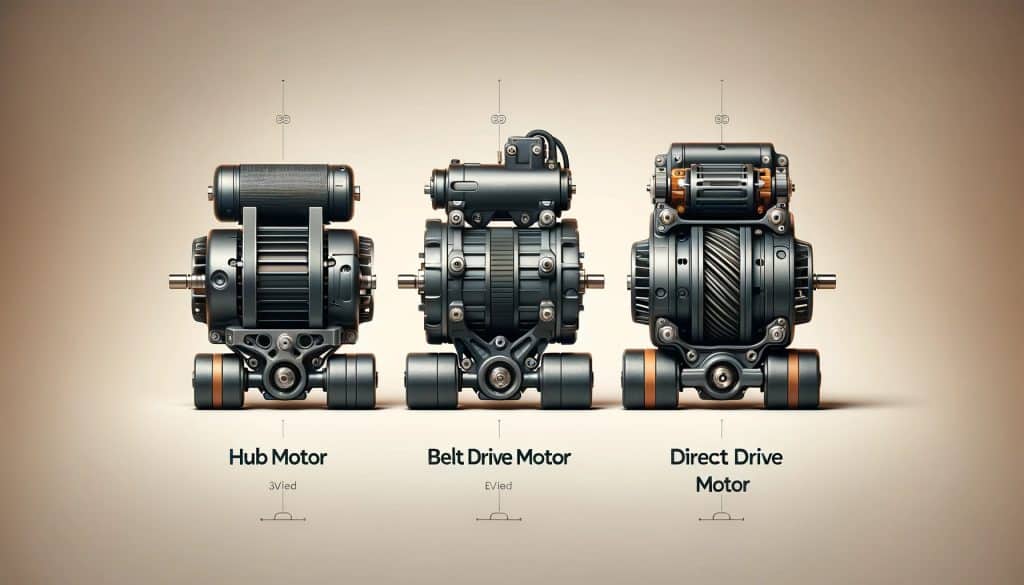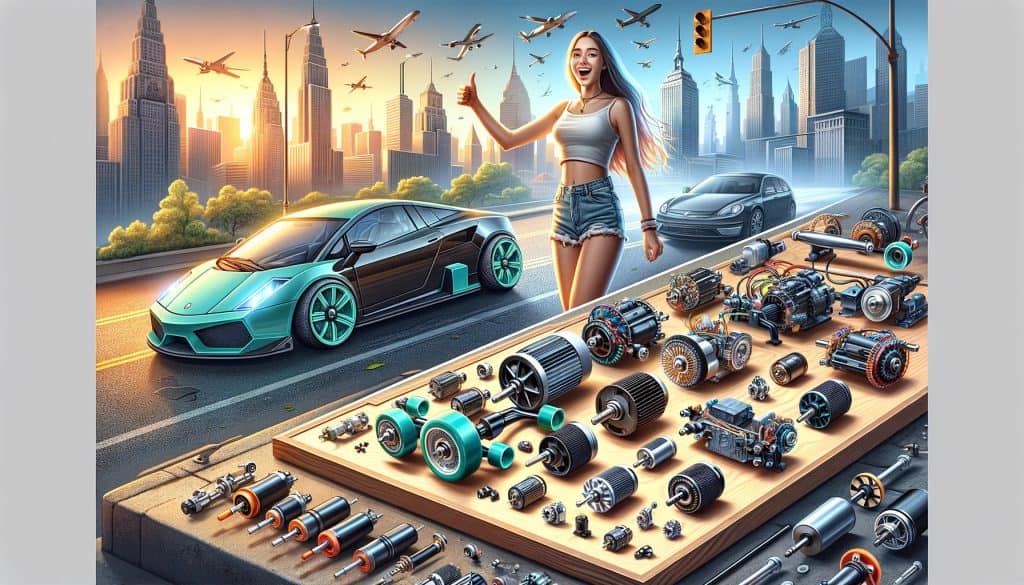Electric longboards are swiftly rolling into the spotlight, transforming how we think about urban mobility. Not just a fun gadget for tech enthusiasts or a niche hobby for skateboarders, electric longboards are now a bona fide mode of transport in bustling cities and quiet neighborhoods alike.
They’re eco-friendly, easy to carry around, and a blast to ride – who wouldn’t want to zip past traffic on one of these sleek boards?
But here’s the thing – not all electric longboards are created equal. The heart of these boards isn’t just the deck or the wheels; it’s the motor.
The type of motor you choose can make or break your riding experience. It’s like choosing between a sports car and a family sedan – both get you from point A to B, but the journey feels entirely different.
Let’s break down why the motor type matters so much:
1. Performance: Just like cars, different motors offer different levels of power and speed. Some motors are built for a smooth, steady ride, while others give you that adrenaline-pumping speed.
2. Range: How far can you go on a single charge? This isn’t just about battery capacity – the efficiency of your motor plays a huge role.
3. Maintenance: Some motors require more love and care than others. You don’t want your ride turning into a weekend project (unless that’s your thing, of course).
4. Noise: Rolling in silence or with a buzz? Motor type dictates how stealthy your ride is.
5. Terrain Compatibility: Planning to climb hills or cruise on flat streets? Your motor decides if that’s a breeze or a battle.
So, choosing the right motor isn’t just a technical decision – it’s about matching your lifestyle, your needs, and even your personality to your ride. Get it right, and your electric longboard becomes more than just a way to get around; it becomes a statement, a faithful companion on every journey, and a whole lot of fun.
As electric longboards continue to gain traction, it’s clear they’re more than a passing fad. They’re a sign of changing times, a step towards greener, more efficient urban travel. And with the right motor under your feet, you’re not just riding on a board; you’re riding on the wave of the future.
< class="wp-block-separator has-alpha-channel-opacity"/>Types of Motors Used in Electric Longboards
The type of motor you choose can vastly influence your ride. Let’s dive into the t ee primary types of motors used: Hub Motors, Belt Drive Motors, and Direct Drive Motors, to understand their mechanics, benefits, and drawbacks.

Hub Motors
Description and Working Principle: Hub motors are integrated directly into the wheels of the longboard. They work by using a brushless motor within the wheel hub, which rotates the wheel directly. This integration offers a sleek, almost invisible motor setup.
Pros:
- Stealthy Design: Blends seamlessly with the longboard, giving it a traditional skateboard look.
- Low Maintenance: Fewer moving parts mean less wear and tear.
- Efficient Energy Use: Tends to have better battery efficiency due to the direct drive system.
- Quiet Operation: Hub motors are known for their quiet ride.
Cons:
- Limited Wheel Options: The integration into the wheel limits customization options.
- Less Torque: Generally, hub motors offer less torque than belt-driven systems, making them less ideal for steep hills.
- Ride Quality: Often, the ride can be stiffer due to the motor taking up wheel space, reducing shock absorption.
Belt Drive Motors
Description and Working Principle: Belt drive motors use a belt and pulley system to transfer power from the motor to the wheels. The motor is mounted onto the board’s truck and connected to the wheel via a belt.
Pros:
- High Torque: Excellent for acceleration and hill climbing.
- Customizable: Allows for a wide range of wheel choices.
- Responsive Control: Offers a more tactile and immediate response to controller inputs.
Cons:
- Maintenance: The belts and pulleys require regular maintenance and can wear out.
- Noise: Tend to be noisier than hub motors.
- Drag: Can create more resistance when pushing the board manually.
Direct Drive Motors
Description and Working Principle: Direct drive motors sit between the board’s truck and the wheels. They directly drive the wheel without any belts or gears, offering a balance between hub and belt drive systems.
Pros:
- Smooth and Quiet Operation: Combines the quietness of hub motors with the power of belt drives.
- Wheel Compatibility: Compatible with various wheel types without affecting the motor.
- Low Maintenance: Fewer parts to wear out than belt drives.
Cons:
- Cost: Tend to be more expensive than other motor types.
- Weight: Generally heavier, which can affect portability.
- Power Efficiency: While balanced, they may not offer the same efficiency as hub motors or the same torque as belt drives.
Each motor type brings its unique flavor to the riding experience. Whether you prioritize power, stealth, or a balance of features, understanding these differences is key to choosing the motor that will best suit your longboarding style and needs.
< class="wp-block-separator has-alpha-channel-opacity"/>Key Factors to Consider When Choosing a Motor
When it comes to selecting the perfect motor for your electric longboard, there are a few critical factors to consider. Each aspect plays a significant role in shaping your overall riding experience, from the t ill of speed to the practicalities of maintenance.

Power and Torque: The T ill of the Ride
- Power: This determines how fast your board can go. A higher-powered motor means faster acceleration and higher top speeds. It’s perfect for speed enthusiasts but might be overwhelming for beginners.
- Torque: This is all about climbing ability and acceleration from a standstill. High torque is your best friend for steep hills and quick starts at traffic lights.
Speed and Range: The Journey Matters
- Speed: Different motors offer varying top speeds. While it’s exciting to have a fast board, consider local regulations and your comfort with speed.
- Range: How far can your board take you on a single charge? Motor efficiency plays a big role here. A balance between speed and range is ideal for most riders.
Noise Levels: The Sound of Silence (or Not)
- Hub Motors: Known for their quiet operation, perfect for a peaceful ride.
- Belt Drive Motors: Tend to be noisier, but many riders love the mechanical sound as part of the riding experience.
- Direct Drive Motors: Strike a balance, offering a quieter ride than belt drives but not as silent as hub motors.
Maintenance and Durability: Ease of Use
- Hub Motors: Require the least maintenance, thanks to their simple design.
- Belt Drive Motors: Need regular checks and replacements for belts and pulleys.
- Direct Drive Motors: Offer low maintenance but can be more complex to repair if issues arise.
Choosing the right motor for your electric longboard isn’t just about technical specifications; it’s about finding the perfect match for your lifestyle and preferences. Whether you prioritize speed, range, quiet operation, or low maintenance, there’s a motor type that’s just right for you. Remember, the best motor is the one that aligns with how and where you ride.
< class="wp-block-separator has-alpha-channel-opacity"/>Motor Efficiency and Battery Life

In the world of electric longboards, the synergy between motor efficiency and battery life is crucial. Understanding this relationship can help you make an informed choice about your longboard and ensure a satisfying ride every time.
Motor Efficiency: The Key to Long Rides
Motor efficiency refers to how well a motor converts electrical energy from the battery into mechanical energy to turn the wheels. High-efficiency motors waste less energy, translating to longer rides on a single charge.
Battery Life: More Than Just Capacity
While battery capacity (measured in watt-hours) is important, how long your battery lasts also depends on how efficiently your motor uses this power. Even a large battery will drain quickly if paired with an inefficient motor.
How Different Motor Types Affect Battery Efficiency
- Hub Motors: Known for high efficiency as they have fewer moving parts and direct energy transfer. This means longer battery life, ideal for extended rides.
- Belt Drive Motors: These can be less efficient due to the energy loss in the belt and pulley system. However, they offer higher torque, making them suitable for performance-focused riders.
- Direct Drive Motors: Strike a balance between efficiency and power, offering a good compromise for those who want both range and performance.
Tips for Maximizing Battery Life with Different Motor Types
- Regular Maintenance: Keep your longboard in top condition. For belt drives, ensure the belts are properly tensioned and not worn out.
- Riding Habits: Smooth acceleration and braking conserve battery life. Avoid frequent starts and stops.
- Proper Storage: Store your longboard and its battery in a cool, dry place. Extreme temperatures can affect battery performance and longevity.
- Regular Charging: Avoid letting the battery drain completely. Regular, partial charges are better for long-term battery health.
- Tire Pressure: Keep your tires at the correct pressure to reduce resistance and increase efficiency.
By understanding the impact of motor efficiency on battery life and following these tips, you can enjoy longer rides and a better overall experience with your electric longboard. Remember, a little care and knowledge go a long way in maximizing the potential of your ride.
< class="wp-block-separator has-alpha-channel-opacity"/>Customization and Upgrade Options

Electric longboarding isn’t just about the ride; it’s also about making your board truly yours. Customization and upgrades are a big part of the electric longboard culture, with each type of motor offering its unique set of possibilities.
Customization with Different Motor Types
1. Hub Motors:
- Wheel Replacements: Customizing wheels can be limited due to the integrated motor, but there are still options for different sizes and hardness.
- Deck Swaps: Change the deck for a new look or different riding experience.
- Battery Upgrades: Increase your range with a higher capacity battery.
2. Belt Drive Motors:
- Extensive Wheel Options: Easily switch out wheels to suit different terrains or preferences.
- Belt and Pulley Modifications: Change the gear ratio for more torque or higher speed.
- Custom Decks and Trucks: Since the motor is separate, you have more freedom to modify other parts.
3. Direct Drive Motors:
- Wheel Versatility: Like hub motors, but with more options due to the external motor placement.
- Battery and Electronic Upgrades: Swap out the battery or upgrade the electronic speed controller (ESC) for better performance.
Popular Upgrades for Each Motor Type
- Hub Motors:
- Higher capacity batteries for extended range.
- Stiffer decks for better stability at high speeds.
- Belt Drive Motors:
- Performance wheels for better grip and control.
- High-torque belts for better uphill performance.
- Advanced ESCs for smoother acceleration and braking.
- Direct Drive Motors:
- Customizable wheels for a balance of speed and comfort.
- Upgraded bearings for a smoother ride.
- Enhanced battery packs for both range and power.
Customizing your electric longboard is not just about enhancing the performance; it’s about expressing your style and ensuring your board fits your specific needs. Whether you’re after speed, comfort, or a unique look, there’s an upgrade for every rider and every style. Remember, the best electric longboard is the one that feels like it was made just for you.
< class="wp-block-separator has-alpha-channel-opacity"/>Real-World Usage: What Riders Say
In the dynamic world of electric longboarding, real-world user experiences offer invaluable insights. By tapping into the vibrant communities and forums where riders share their stories, we can glean a wealth of knowledge about the practical aspects of different motor types and their impact on the riding experience.

Gathering Insights: The Voice of the Community
Electric longboard enthusiasts are not shy about sharing their experiences. From dedicated forums to social media groups, riders of all levels discuss every aspect of their boards, offering a treasure trove of real-world insights.
Hub Motors: The Urban Cruiser’s Choice
- Feedback: Riders love the stealth and simplicity of hub motors. They’re often praised for their quiet operation and minimal maintenance needs.
- Common Themes: Perfect for commuting and casual riding. Some riders wish for more torque for hill climbing, but appreciate the efficiency for longer rides in the city.
Belt Drive Motors: The Performance Aficionado’s Dream
- Feedback: Enthusiasts rave about the power and acceleration that belt drive motors provide. They’re a favorite among speed lovers and hill climbers.
- Common Themes: The need for regular maintenance is a common talking point, but many find it a worthy trade-off for the performance boost.
Direct Drive Motors: The All-Rounder
- Feedback: Direct drive motors receive praise for their balance between performance and ease of use. They’re often highlighted as a great middle-ground option.
- Common Themes: Riders appreciate the versatility in wheel choices and the smoother ride compared to hub motors, though some note they’re not as punchy as belt drives.
A Motor for Every Rider
Each motor type has its champions and its critiques. Hub motors are celebrated for their ease and efficiency, belt drives for their raw power, and direct drives for their balanced approach.
What’s clear is that the perfect motor type depends on the individual rider – their style, their needs, and their terrain. By listening to the voices of the community, any rider can find guidance and perhaps even see a reflection of their own longboarding aspirations.
< class="wp-block-separator has-alpha-channel-opacity"/>Conclusion: Choosing the Perfect Motor for Your Electric Longboard
As we’ve journeyed t ough the world of electric longboard motors, we’ve uncovered the nuances that make each type unique. From the quiet efficiency of hub motors to the powerful punch of belt drives, and the balanced approach of direct drives, each has its place in the longboarding world.

Recap of Key Points:
- Hub Motors: Ideal for those seeking a low-maintenance, efficient ride, perfect for city commuting.
- Belt Drive Motors: The go-to for performance enthusiasts who crave speed and torque, despite the higher maintenance needs.
- Direct Drive Motors: Offering a middle ground with a blend of efficiency, power, and versatility in wheel choices.
Final Thoughts:
Choosing the right motor for your electric longboard boils down to your personal riding style, needs, and the environments you’ll be traversing. It’s not just a technical decision; it’s about what feels right under your feet.
Whether you’re cruising t ough city streets, carving up hills, or just enjoying a leisurely ride by the beach, there’s a motor out there that’s tailored for your adventures.
Remember, the best electric longboard is the one that aligns with your lifestyle and brings a smile to your face every time you hit the pavement. Happy riding


